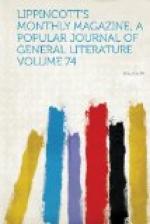In describing a Japanese marriage in high life we do not intend to soar too high. It is not for our alien pen to portray the splendors of such a marriage as that of the princess of Satsuma to Iyesada, the thirteenth Sho-gun of the Tokugawa dynasty, when all Yedo was festal and illuminated for a week. Neither shall we describe that of the imperial princess Kazu, the younger sister of the Mikado, who came up from Kioto to wed the young Sho-gun Iyemochi, and thus to unite the sacred blood of twenty-five centuries of imperial succession with that of the Tokugawas, the proud family that ruled Japan, and dictated even to her emperors, for two hundred and fifty years. We leave the description of those royal nuptials to other pens. Ours aspires only to describe a marriage such as has happened in old Yedo for the thousandth time in the samurai class—the gentry of Japan.
Were you with us in Tokio (the new name of the capital of Japan) we should take you, were you inclined to go, to the place where once stood the mansion of Yamashiro Kan, a high retainer of the prince of Echizen, and a lineal descendant of the great Iyeyasu, the founder of the dynasty of the Sho-guns. Were you to seek for Yamashiro’s mansion now, you would not find it, but instead several very vulgar evidences of the Western civilization which is now changing the Land of the Gods into a paradise of beef, bread, butter, milk and machinery. We walked past the old mansion-grounds a few days ago, and lo! we saw a milk-shop and dairy, a butcher’s stall, a sewing-machine store, a printing-office, a school in which Japanese boys were learning A, B, C’s, a photographer’s “studio,” a barber-shop with an English sign, and a score or more Japanese shops of all kinds. This is of to-day. Five years ago a long wall of diamond-shaped tiles laid in white cement extended round the spacious grounds of the homestead of the Yamashiro family. Inside were fish-ponds, mimic hills, miniature mountain-scenery, dense flower-bushes, dwarfed arboreal wonders, solemn shade trees and a garden laid out according to the very best Japanese style. The fine old yashiki of Yamashiro, with its porter’s lodge, stone path, entrance-porch, vestibule and the family homestead, was within. No wonder, then, that the aged man, who firmly believes that Japan is going to the dogs, the devil or the foreigners—he does not know which—shakes his head as he now passes by the milk-and butcher-shops, around which the lazy dogs sleep or wait for bones, and sighs as he remembers the grand old mansion.
About two miles farther north, in the great rus urba of Yedo, was another house of humbler pretensions, and yet one with a gate and garden of dimensions betokening the residence of a man of rank. It was the home of Nakayama, one of the eighty thousand hatamoto (vassals) of the Sho-gun, a studious gentleman whose greatest pride was in his two sons and his only daughter. The former were not only manly and expert in the use




